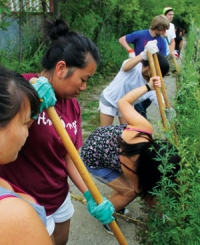The odors and toxins that pervaded the water are thankfully but a memory. As the fish came back, so did the people who love to catch them. Many spontaneous trails developed along the river’s edge braiding the banks as mountain bikers, hikers, nature enthusiasts and dog walkers found solace in this healing sanctuary. In those early years we’d often have to bring a machete to make it through thick plant growth as there was no East Bank Trail (there is now thanks to the good work of the River Revitalization Foundation) and the west side was often overgrown. Few knew that much of this land was private as the owners, mostly businesses, rarely ventured to the river. A kind of happy anarchy existed. People did what they wanted and trails formed to match this use.
Fast forward to today. Not only has the river continued to improve, but thanks to thousands of volunteers, invasive plants have been replaced with native vegetation. In some areas, especially near the Urban Ecology Center, the resulting biodiversity is impressive. Much of the private land (through purchase, easements and agreements) has been converted to public use so people are no longer inadvertently trespassing. More people are using this natural asset than ever before. This is a good thing. People who know the land love it and people who love the land protect it!
A few years ago, the Milwaukee River Greenway Coalition (which grew from the community) took a step back to look holistically at both the use of the river and the trails needed for access. Much neighborhood outreach ensued. A lot of never asked questions came up. Should dog walking be allowed? Are mountain bikes hurting the land? Are fisher people being responsible stewards of the river banks? Do we really even want people down there at all; maybe it should be left for the wildlife? Hard questions to answer especially when some uses impact others and not everyone embraces everyone else’s activity.
I remember the meeting (and we’ve had a ton of public meetings) to discuss all of this, when a group of about 40 of us were arguing the issues associated with different uses. Jessica Binder (now of the Bicycle Federation) quietly suggested the radical idea of sharing. She pointed out that the existing anarchy has actually worked pretty well. Sure there is the occasional conflict and flare up, but by and large folks on the river are respectful and kind. Her comments resonated with us all and a new “shared use policy” was agreed upon as an idea to promote. The thought was, let’s not welcome users with a sign full of all the things you can’t do, but instead encourage a culture of responsible shared use for everyone. So the question changed; where should we encourage different activities? Where is the best place for biking? Where is the best place for nature study? Where does it make sense to encourage those with limited mobility to visit?
The Coalition grappled with these questions and created a well-vetted plan for trail use, construction and maintenance for the entire 800 acres.
It was determined during this process that it made sense for the Urban Ecology Center to be a central hub to this amazing natural resource. Thus the Milwaukee Rotary Centennial Arboretum was born to serve as a gateway. The west bank was determined to be the best place to leave rustic. Cambridge Woods, with the most biodiversity, is great for nature lovers. A leash-less dog park was created in Estabrook Park.
Many of the spontaneous trails along the river which have been in use for years will continue to be enjoyed for years to come. Unfortunately, though, some trails, which are in high use areas or very close to the river, have become a detriment to water quality. Dirt paths that run close to the bank of the river often end up collapsing and adding excessive sediment to our waterways. Sedimentation affects the clarity and sunlight penetration into the water which affects the flora and fauna. Sediments also bond with pollutants and carry them downstream to Lake Michigan. By building more sustainable trails above the floodplain, we can minimize negative effects on water quality while enhancing recreational enjoyment.
Last year we embarked on the first phase of creating accessible, sustainable trails for Riverside Park and our extended Rotary Centennial Arboretum boundaries. Closer to the Center we repaved some of the historic trails originally designed by Frederick Law Olmsted in 1893. When the Arboretum is complete there will be a network of universally accessible trails near the Center that will, for the first time, allow those in a wheelchair to independently navigate the park and even the river bank! Emanating from these paved paths in either direction are gravel paths that an ambitious wheelchair user can explore. And the further you get from this high-use area, the primitive dirt trails will remain for all to enjoy.
This game of preserving, managing, restoring and naturalizing public green space in our fair city is not for the faint of heart. If you accommodate one group you often alienate another. Decisions are made, but implementing plans can sometimes take years! This means that current users can feel left out of the process (users can join coalition groups here http://www.milwaukeerivergreenway.org/coalition/). It’s a fine and tricky balancing act that is more art than science. We hope you all will come down and enjoy the growing results of our hard work.
This article was co-written by Ken Leinbach, Executive Director, Kim Forbeck, Senior Land Steward and Tim Vargo, Manager of Research & Community Science





